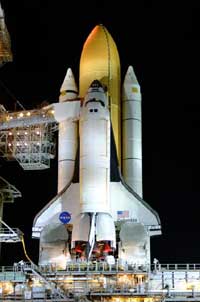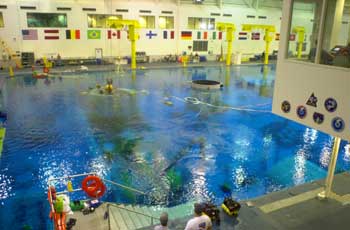
Hubble Revisited
by Mary K. Miller
|
Last
spring, an Exploratorium Webcast team took you on a
tour of the
Hubble Space Telescope
. We went behind the scenes
at the
Space Telescope Science Institute
in Baltimore,
and peered over the shoulders of scientists and image
specialists as they focused the space telescope on objects
in deep space and created amazing images of the Horsehead
Nebulae. We also got a look at space hardware destined
for Hubble during a live Webcast inside the giant clean
room at NASA's
Goddard Space Flight Center
in Greenbelt, Maryland.
Now, astronauts, aerospace engineers,
and space shuttle flight controllers are getting ready
to launch the fourth servicing mission to Hubble to
exchange some worn-out parts and place a powerful
new camera on the twelve-year-old space telescope.
On March 1, 2002, the space shuttle Columbia will
blast off the pad at
Kennedy Space Center
and dock with Hubble 360
miles above earth. Two teams of astronauts will spend
five days of space walks (known as Extra Vehicular
Activity or EVAs) repairing and improving the vision
of one of astronomy's most important telescopes. From
liftoff through the last EVA, the Exploratorium Webcast
team will take you along on the mission and introduce
you to scientists who are anxiously awaiting the new,
improved Hubble and what it will tell us about the
structure of deep space and the origins of the universe.
|

The Space Shuttle Columbia
|
Getting Ready to Fly

Neutral Buoyancy Lab
|
Preparing for this shuttle mission,
known as
Hubble Servicing Mission 3B
, has been a two-year
process of prepping new instruments and space hardware
for flight, and training space-walking astronauts in
one of most complex and technically challenging servicing
missions to date. Some of the Hubble instruments were
not originally designed to be replaced, so special tools
were developed. Astronauts went through months of training
for each task, including hundreds of hours in the "tank,"
or
Neutral Buoyancy Lab (NBL)
, at
Johnson Space Center
in Houston.
|
The NBL is a six-million-gallon pool,
100-by-200-feet wide and 40-feet deep, that contains full-scale
models of the space telescope on one end, and the pods of
the International Space Station on the other. Being underwater
is about the closest way of simulating space walks on earth,
so astronauts use the NBL to practice handling new tools
and learning the steps involved in each task they'll perform
in space. It's a laborious process. First, they don their
space suits and are lowered by crane into the pool. Once
in the water, scuba divers tend to them, filming their every
move and staying close in case equipment fails and the astronauts
need assistance.

Exploratorium crew interviews
astronaut John Grunsfeld
|
The
Exploratorium team caught up with the astronauts training
at NBL last summer and talked with Astrophysicist and
Shuttle Payload Commander John Grunsfeld (we'll show
our interview with Dr. Grunsfeld on the second Webcast
scheduled for March 2). This will be Dr. Grunsfeld's
second visit to Hubble; he was also on hand for the
emergency servicing mission in December 1999 to replace
failed gyroscopes that had stopped pointing the telescope
properly.
|
"For every hour we spend in space, we'll
practice 10 to 12 hours in the pool," Grunsfeld says. "These
are very highly choreographed tasks, like a ballet where
you have to know every move ahead of time. The amazing thing
about our training here is that when you get to space, although
the feel and the look of it is very different, training
your motor skills is very similar."
As a working astronomer, John Grunsfeld
especially appreciates his experiences visiting Hubble in
space and helping to keep this valuable tool working at
its peak performance. "To me, it's an absolute dream to
go work on the Hubble Space Telescope, "he says. "I was
awestruck. It's so beautiful, and to be able to reach out
and touch the telescope was really like a dream."
In addition to their pool work, astronauts
also spend time preparing for the mission in the shuttle
mock-ups at Johnson. Full-scale replicas of the shuttle
- both in its launch (nose up) and flight configurations
(horizontal) - help the astronauts get used to the tight
quarters and the equipment they'll work with during launch
and flight operations inside the space shuttle. In the months
preceding the servicing mission, the team also visited Goddard,
where they got a close-up look at the hardware that will
go up with them to Hubble.
Giving Hubble New Sight
All that training is in preparation for
the big space show that begins on March 1. It starts with
the launch, scheduled for 6:38 a.m. Eastern time. Staff
Physicist and Webcast Co-host Ron Hipschman will be on hand
for liftoff. On the first Webcast, which airs March 2, he'll
relate what it's like to be near the launch pad and what
he learned about the operations at Kennedy Space Center
in Florida.

Mission control in Houston
|
After the launch, ground operations
take over at the Johnson Space Center in Houston. There
in the control room, nineteen teams of engineers, flight
controllers, flight surgeons, communications specialists,
and others track, advise, and control operations in
space. It will take the space shuttle Columbia a few
days to rendezvous with Hubble and come to a near crawl
in relation to the telescope. On flight day 3, Flight
Engineer Nancy Currie will use the shuttle's robotic
arm to grapple the telescope into the shuttle bay and
retract the telescope's solar panel "wings" in preparation
for replacing them with more compact and powerful solar
panels.
|
EVAs start on flight day 4, when payload
commander Grunsfeld, together with veteran astronauts Jim
Newman and Rick Linnehan and space rookie Mike Massimino,
will take two days to replace the solar arrays and prepare
for a changeout of the power control unit. According to
Houston Flight Director Bryan Austin, the third EVA, on
flight day 6, will be the most challenging. That's when
the old power control unit will be removed and replaced
with a new one. This is hardware that wasn't originally
designed to be replaced and has thirty-six closely spaced
and delicate connectors. It's likely to take the entire
day, and ground controllers will have to watch carefully
to make sure the astronauts don't use up all their battery
power and oxygen.
EVA 4 is the day that scientists are most
excited about. That's when the
Advanced Camera for Surveys (ACS)
, a telephone-booth-sized
instrument, will be placed into the telescope, allowing
for many more opportunities for discovery. The camera will
increase Hubble's vision into deep space ten-fold, will
provide two times the observational area, two times the
resolution, and four times the sensitivity than the camera
it's replacing. The designers of the advanced camera think
it may even be powerful enough to take an image of planets
in other nearby solar systems.
On the last day of planned space walks,
EVA 5 (flight day 8) astronauts will replace a
cooling system
to restore the infrared vision of Hubble.
Once they close up the telescope, they'll give it a boost
to a new, higher altitude and release Hubble back into space.
Future of Hubble
After the astronauts have given the space
telescope its send-off and returned to earth, telescope
operations will resume at the Space Telescope Science Institute
in Baltimore. About three weeks after the mission, Hubble
will start collecting science observations again and the
advanced camera will take its first test pictures. With
ACS, astronomers will be able to look in the gaps around
bright stars for clumps of dust and gas that may be early
signs of planet formation. The new instrument will also
be useful for astronomers who study quasars, powerful distant
objects in the farthest reaches of the universe that are
thought to be highly active black holes in the center of
galaxies.
|
![]()
![]()